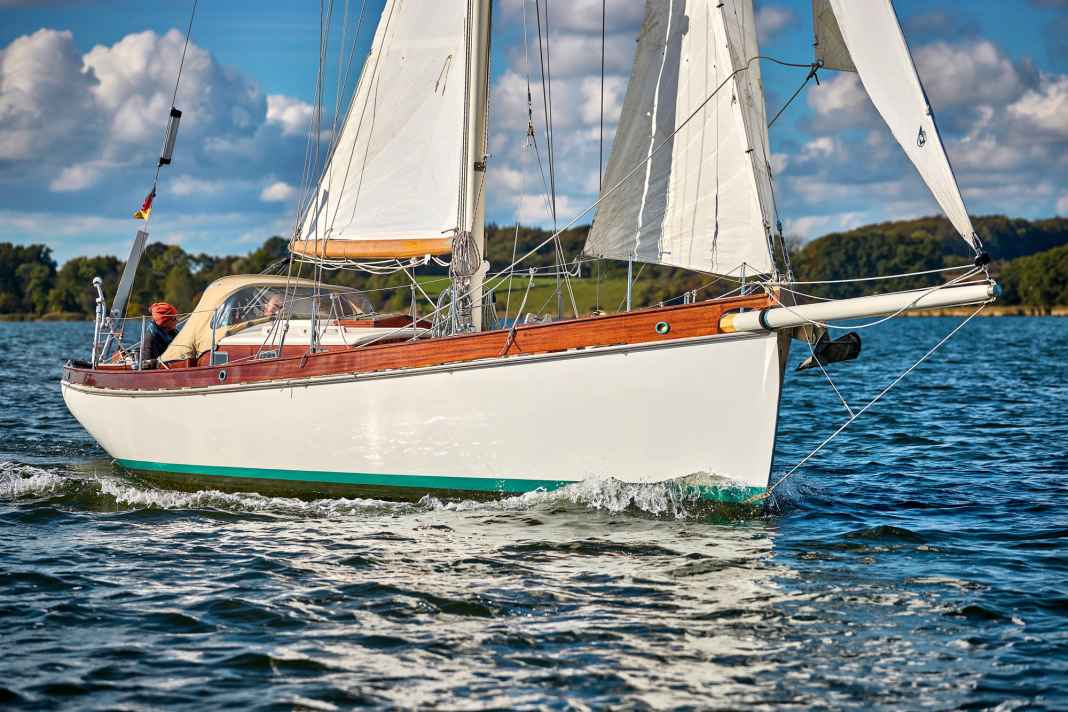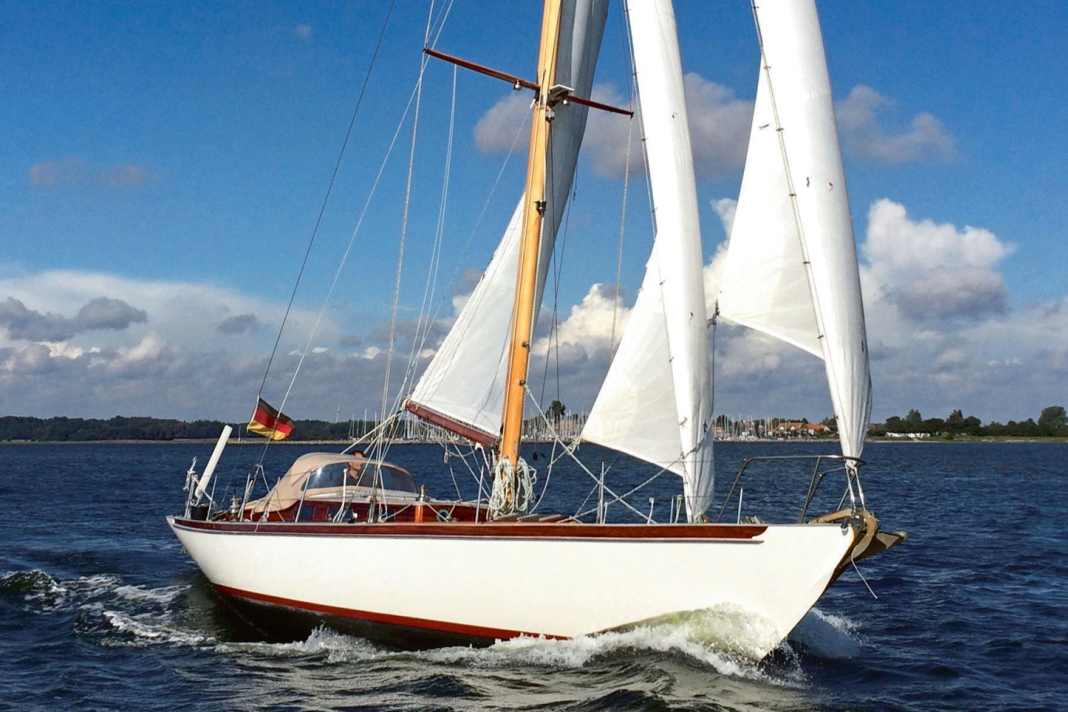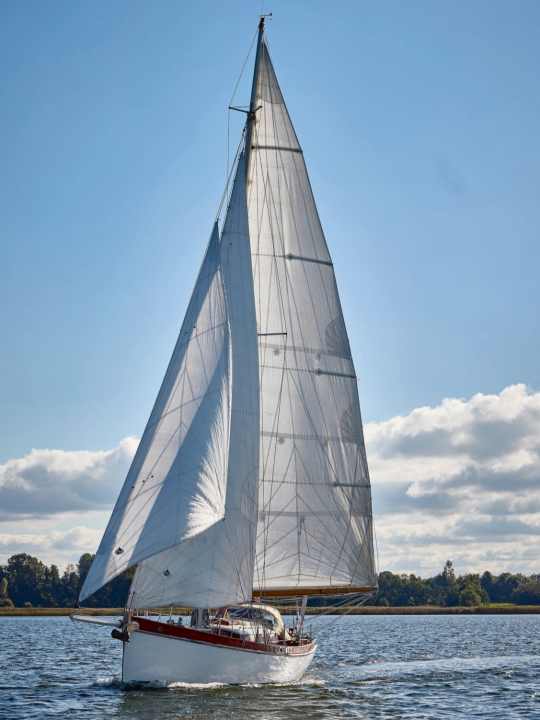





When Frank Rinow sat on the shore of the Baltic Sea at the age of six and gazed at the horizon, he knew exactly what he wanted to do one day: go out to sea in his own sailing boat - as far out beyond the horizon as possible. He had learnt to know and love the maritime world at an early age with his parents and in his own Opti - but that wasn't enough for him. He wanted to go out to sea, far away and for a long time.
Other special boats:
Today, Frank is 65 years old, has broadened his horizons considerably, has sailed many thousands of miles and has built three of his own yachts in addition to numerous shipyard contracts. "Sailing has been an important part of my life since I was a child. And it was always wooden yachts that I dreamed of," says the boat builder. Realising this dream became Frank's layline, the common thread in his life.
Owner launches first self-built vessel
As there was no money in his pockets, he decided to complete a boatbuilding apprenticeship after leaving school. He travelled all over Schleswig-Holstein and finally signed an apprenticeship contract in Tönning. From 1983, he built traditional workboats for fishing out of oak at the Dawartz cutter shipyard in Tönning - by the sweat of his brow and in the hurricane of an unpredictable boss. After completing his apprenticeship and several years as a journeyman, he began to lay the keel of his first own yacht in 1990: "Stina". During these years, Frank worked at the traditional yacht and boatyard Willy Stapelfeldt in Kappeln on the Schlei. He had time to build his own yacht after work or at weekends - even all day in the summer months, when the shipyard had long company holidays for the sailing boss and all employees.
The self-built "Stina" was inspired by the classic sailing yacht "Stormy Weather", a 16-metre cruising and racing yacht designed in 1933 by Sparkman & Stephens. Olin Stephens designed the boat, which was successful in many regattas and also proved itself on the high seas during six Atlantic crossings, at the age of just 25. In a barn in the north of Hamburg, the self-drawn "Stina" grew steadily and took shape under the hands of the industrious boat builder. The 12.50 metre long construction was made entirely from Kambala, a hard, tropical wood from Africa, and after three years of intensive construction, the yacht was finally completed.
"Together with my wife Stine, we enjoyed many wonderful trips on the Baltic Sea, the North Sea, the Mediterranean and even the Caribbean," says the boat builder, looking back with satisfaction.
"Sailing has been an important part of my life since I was a child. It was always wooden yachts that I dreamed of."
The idea for "Stella" matures
The time spent in mild climes led to the idea of building an additional boat and mooring it in Mallorca for the winter months. The money needed for the material costs was to be raised by selling a folk boat, which the ambitious boat builder launched in 2001. In the course of his master craftsman's examination, he built a flawless Nordic folk boat - planked with larch and built on oak.
The next new build was to meet the requirements of the Mediterranean: a length of less than ten metres to save on mooring fees, good handling for a small crew and safe sailing behaviour even in strong winds. At the same time, the new yacht should be traditionally built and require as little technical equipment as possible.
Frank's passion for sailing and the desire to build his own boats had already put several yachts on the water, and so this vision actually became a wooden reality: "Stella" was launched in the master boat builder's garden in a suburb of Hamburg. A foil tent served as a hall and the workshop was housed in the double garage. "The financing didn't fall from the sky. But as planned, the sale of my masterpiece helped to finance the construction of the next boat," explains Frank.
This time, Frank modelled his new design on English workboats - in particular the Pilot Cutter and Falmouth Oyster Cutter. The pilot cutters in the English Channel developed from the middle of the 19th century. These seaworthy, fast and easy-to-handle boats could also be sailed by a small crew. As soon as the pilot had transferred, two men had to sail the ship back - in summer and winter. That was hard work. "In contrast, the Falmouth Oyster Cutters are more like bonsai versions of the pilot cutters.
What they do have in common, however, is the steep stern, the overhanging stern, a powerful deck jump and, of course, the gaff rig," explains Frank, who meticulously read up on the history and did thorough research for his new build.
Near-miss during construction
For his planned ten-metre yacht, he adopted some of the visual and design elements of these ship types, particularly visible in the straight bow, the strongly positive stern and the long keel. "The S-frame and a moderate long keel ensure good-natured sea behaviour and good manoeuvrability," says Frank, who designed the new build according to the standards of Germanischer Lloyd.
The boatbuilding professional procured the wood as a whole log and sawed it himself. The hull was traditionally planked with 28 millimetre thick Sapelli mahogany on laminated frames made of the same wood. The stem was made from solid Sipo wood and the entire hull was then coated with fibreglass and epoxy below the waterline. For the deck, the boat builder chose eight millimetre thick teak on twelve millimetre plywood.
"We don't have children, but I imagine the feelings at a birth to be a bit like the launch."
The bulkheads are made of marine plywood. The panelling with wooden panels embellishes the structural units below deck. "Basically, there were no nasty surprises," says Frank, summarising the construction phase. "The highlights for a boat builder are usually in the evening - when I've built something nice and looked at it again. That's what this job is all about."
It was only during the production of the keel that Frank experienced a moment of shock: after he had delivered the casting model for the ballast keel to the Danish foundry in Svendborg, he checked his volume calculation at home - and realised that he had miscalculated. The keel would have been several hundred kilos too heavy! He frantically travelled back to Svendborg to change the model - with success.
The wooden keel was glued from 2 x 65 millimetre thick wood and bolted to the ballast keel with 14 stainless steel bolts (V4A). The 3.3 tonnes weight of the external lead ballast keel corresponds to 43 percent of the total weight, a very high proportion that stands for great stability.
Around 7,000 construction hours and six years of construction time
His small private shipyard caused a stir in the neighbourhood. After all, deliveries of wood and materials were now more frequent, and loud machine noises could be heard coming from the thin foil tent. The boat builder was able to satisfy the neighbours' curiosity with tours of the construction site and stories of sailing.
Frank took a lot of time to build "Stella", after all he still had a job at the shipyard and a cruising boat in the harbour, the "Stina", that needed to be moved regularly. "This lifestyle and my boatbuilding projects were supported by my wife Stine. When I built boats in the summer, she worked and earned money. And we did all the trips together," says Frank, explaining the duo's concept.
After around 7,000 hours of work and six years of construction, the time had finally come: "Stella" was lifted out of the foil tent with a crane and hovered high above the apple tree in the garden before being set down safely on a trailer on the road - over tarmac to Kappeln an der Schlei. "I could hardly believe it, it was done!" remembers Frank. A lot of adrenaline was pumping through his veins during the launch, although he was already familiar with moments like this: "We don't have children, but I imagine the feelings at a birth are a bit like the launch - when the ship rushes into the water and floats for the first time. And then right on the waterline! It's very emotional," says Frank.
40 years of professional experience culminate in "Stella"
The first tests and trial strokes confirmed: well calculated, perfectly executed and also visually successful - the work had paid off. The well-balanced rudder provides pleasant rudder pressure, the boat sails stably and safely. "It was a load off my mind. But after 40 years of professional experience, you should know how to do it," smiles Frank.
Once again, the passionate boat builder had proven how to formulate a clear goal from a vision and realise it in such a way that in the end a yacht like "Stella" is launched - "which is maximally seaworthy with a minimal crew even in difficult conditions", as her builder describes it.
In addition to the self-drawn outline for the hull, Frank also focussed on the sail plan. Setting and recovering all the sails had to be simple, the technique uncomplicated and reefing and rigging fast. He therefore decided against the gaff rig typical of pilot cutters, which requires many kilograms of material to be attached to the mast and moved. Instead, he opted for a three-quarter Bermuda rig, cutter-rigged with two headsails: The jib is furled on a furling system, the jib on staysails. This gives "Stella" a sail area of 75 square metres on the wind. The bowsprit can be pulled inwards onto the deck to reduce the overall length of the yacht in the harbour.
The sails are made from Hydranet cloth in a radial cut. The entire running rigging is made of low-stretch Dyneema, while the standing rigging is made of stainless steel - with ten millimetre thick shrouds and eight millimetres for the backstay and forestay. The backstays run over 2:1 tackles with lever clamps and are tensioned via winches on the aft deck. Robust, shiny chrome Andersen winches in veritable sizes 40 and 46 are used for working with sheets and halyards.
Mix of traditional and modern materials
The mast of the "Stella" is a traditional, hollow spruce wood mast with reduced wall thickness to save weight, which Frank built himself at the shipyard. Inside, it was laminated with carbon fibre unidirectional scrims - a special fibre composite layer that distributes all strands parallel and homogeneously. According to Frank, this is particularly advantageous for components that are subject to bending loads, such as a mast.
The mix of traditional and modern materials is also evident in the superstructure: The plywood coachroof is coated with a glass mat, the sides of the superstructure are made of Sapelli and the side window frames are made of bronze. There is a large skylight on the roof - very classic - which provides plenty of light and good ventilation in the saloon. There is a manual anchor winch on the foredeck and a wind vane mounted on the stern as an autopilot. "The boat is designed as a durable long-distance vessel. The technical equipment has been reduced to the bare essentials and designed to be as manually operable, robust and easy to maintain as possible," explains Frank.
The concept of longevity and the deliberate avoidance of energy-intensive and failure-prone consumers is also consistently applied below deck. There is no refrigerator; heating is provided by a diesel vaporiser from Refleks, which is attached to the forward bulkhead. In the galley, a traditional paraffin cooker from Taylor's in England provides reliable service.
"Stella" proves to be an ideal cruising boat
The atmosphere on board is cosy and rustic - the lovingly crafted woodwork and the warm light in the saloon turn a visit on board into a journey back in time to the past century of sailing. The chart table and navigation area to starboard has the same dimensions as the opposite galley with cooker and sink, behind which is the spacious saloon with benches and a folding table; the headroom is 1.85 metres.
In addition to the double berth in the bow, there is a toilet and washbasin in the foredeck. The interior fittings and deck beams are made of sipo mahogany, the heartwood of which is characterised by its warm red-brown colour. Four people can be comfortably accommodated on board - in the double berth in the foredeck and on the saloon benches. Ample storage space throughout the boat allows for many nautical miles without going ashore. "On long trips between Norway and the Mediterranean and in all weather conditions, 'Stella' proved to be an ideal cruising boat," summarises the owner couple, who often lived on board for months at a time.
So far, boat builder Frank has designed, drawn, built and sailed three of his own yachts. He has also been an important part of the team on more than twelve shipyard contracts. In "Stella", his latest work, all the experience, skills and knowledge of his many years of work in wooden boat building come together. He doesn't want to put the plane down quite yet - even if no more boats are to be launched. A pity, really.
The self-built predecessors of the "Stella"



Technical data of the "Stella"

- Year of construction: 2009-2015
- Torso length: 10,30 m
- Total length: 13,00 m
- Width: 3,00 m
- Depth: 1,80 m
- Weight: 7,5 t
- Sail area on the wind: 75,0 m²

